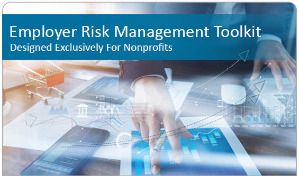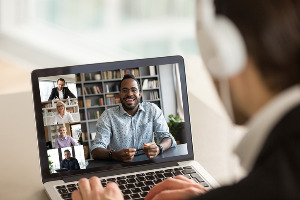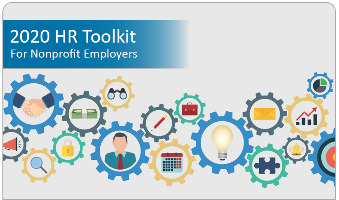
The Coronavirus has presented a whole new set of challenges to the nonprofit sector—one of the most prevalent being the impact of unpredicted unemployment costs. To help nonprofit employers address (and avoid) future UI risks, we’ve compiled our top resources to create the 2020 Employer Risk Management Toolkit.
As nonprofits continue to struggle in the current economic environment, it’s more important than ever to recognize and manage unemployment risk. This free toolkit includes unemployment cost management strategies, a UI Integrity infographic, fraud prevention tips, and more:
Want access to more nonprofit-specific tips, toolkits and webinars? Sign up for our nonprofit eNewsletter today!

In our third and final UST Live webinar, we welcomed three human resource leaders from across the U.S. with expertise in recruitment best practices to discuss innovative strategies for interviewing and hiring best-fit job candidates, while showcasing brand and culture, in the age of the Coronavirus. You’ll also learn about the latest recruiting tools that your HR peers have leveraged during the pandemic.
Watch now to discover:
As nonprofit employers and their employees continue to navigate the many unknowns of the Coronavirus—and its impact on future business—UST remains committed to supporting the sector with reliable and timely content for managing the day-to-day challenges of COVID-19.

As we continue social-distancing—heavily relying on virtual resources—large-scale events have taken on a whole new look and feel. With 2021 right around the corner, NOW is the time to map out what your nonprofit’s event strategy will look like in the new year and beyond.
While the idea of hosting a virtual event might seem overwhelming, with thoughtful planning and the right support, achieving exceptional results is possible. Virtual events offer the best combination of brand exposure and the digital engagement people crave. Whether your event is large or small, one day or one week, we’ve compiled some of the top Virtual Event Best Practice Tips to help you navigate the many considerations involved in planning (and executing) a successful virtual event.
Want access to more nonprofit-specific tips, toolkits and webinars? Sign up for our nonprofit eNewsletter today!

UST’s latest interactive webinar series, “UST Live,” brings the collective expertise of reputable nonprofit leaders to you—live—in virtual panel discussions.
In our second UST Live webinar, the panel discussed new (and successful) strategies nonprofit leaders have implemented since COVID-19 began, as well as common hurdles nonprofits are facing with future strategy development. Plus, get YOUR questions answered first-hand by your nonprofit peers—who have tremendous experience in strategic thinking and organizational sustainability best practices.
Watch now to discover:
Upcoming UST Live Webinars: In our final session for 2020—scheduled for November 19th—we’ll discuss innovative recruitment best practices that can help nonprofits attract quality job candidates during (and after) a pandemic.

To help nonprofits combat the most prevalent day-to-day workforce challenges caused by COVID-19, UST has launched a NEW interactive webinar series called “UST Live.” We’re collaborating with reputable nonprofit leaders & HR experts across the U.S. to bring their collective expertise to you—live—in hour-long, virtual panel discussions.
In our first UST Live webinar, the panel discussed the innovative employee management strategies that are being used for onboarding, training, employee development and employee engagement during these difficult times. Plus, the panel answered attendee’s questions related to HR best practices and employee relations management.
Watch now to discover:
Upcoming UST Live Webinars: This webinar series was designed to equip nonprofits with the strategies and resources they need to survive (and thrive) throughout this pandemic. Be sure to register for our next UST webinars—scheduled for October 15th and November 19th—where we’ll discuss how to develop a sustainable strategy for 2021 as well as innovative recruitment best practices.

The Coronavirus pandemic has pushed the economy into a sudden and deep recession, impacting local businesses as well as a number of large corporations. But the effects of this pandemic on the nonprofit organization has been even more substantial and unfortunately, gone unnoticed. Many citizens rely on the services nonprofits provide such as, social services, medical care and spiritual community. Tens of thousands of nonprofits are likely to close without the support of some kind of rescue package to help keep their doors open. The nonprofit sector is the nation’s third-largest private employer, with 1.3 million nonprofits employing nearly 12.5 million people—about 10 percent of the total number of people working in the private sector.
According to the John Hopkins University 2020 Nonprofit Unemployment Report, more than 1.6 million nonprofit jobs have been lost between March and May of 2020. Private education nonprofits lost an estimated 323,201 jobs, while health care lost an estimated 574,530. As we know, nonprofits come in many shapes and sizes, ranging from large organizations, like city hospitals to small mom and pop thrift shops that help support local charities. No matter the size, nonprofits have been severely impacted by the pandemic in more ways than one. Many nonprofits are unable to perform normal day-to-days tasks due to the number of shutdowns and social distancing requirements. For food pantries and free clinics, the economic disruption has caused an increase in clients in need of these services. While many think of nonprofits as running predominately on donations, roughly half of their revenue come from billing for services, a third from government contracts and grants, and only about 9 percent from individual donations.
While some foundations and charitable-giving funds have seen an increase in their donations, other nonprofits have not had the same luck due to relying on revenue-generating activities and fundraising. Making it not only difficult to keep people on the payroll but also impacting long-term viability of their organization.
Many nonprofits were eligible for federal pandemic aid under the Paycheck Protection Program, which extended potentially forgivable loans to small employers to keep workers on the payroll. But qualifying for such aid can be difficult. Give Kids the World received $1.75 million, however, organizations like the Y.M.C.A. of Metropolitan Chicago were left out because they had more than 500 employees.
The nonprofit sector has more of an impact on the overall economy than many realize—offering crucial contributions to the country’s health, education, social service, and cultural activities. Nonprofits not only make up the country’s third largest workforce but also generate the third largest payroll of any national industry while making important contributions to the tax revenue of the country’s national, state, and local governments. The devastation of this pandemic has put many individuals out of work while closing the doors of many other beloved nonprofits—putting pressure on the vital services these organizations offer their communities.

Here at UST we’ve put together our Top 10 Guides for 2020 Nonprofit Human Resource management. And for a limited time, we’re giving them away for FREE.
Since 1983, UST has provided nonprofits with the latest HR resources in an effort to help organizations stay compliant, maximize employee bandwidth and reduce overhead costs. This toolkit includes updated 2020 state and local minimum wage data and recordkeeping requirements, as well as a variety of checklists to ensure compliance. Plus, you can discover facts surrounding COVID-19 laws and the latest workplace protocol.
Still have questions? You can get a free 60-day trial of UST HR Workplace, powered by ThinkHR. This cloud-based HR platform offers a live expert hotline, 300+ online training and compliance courses, compensation tools, employee handbook builders and employee classification step-by-step guides. Set up your ThinkHR Trial today!

As nonprofit organizations prepare to return to business as usual, there are quite a few new safety protocols being put in place to ensure that employees return to a safe work environment. The Center for Disease Control – CDC continues to release updated guidelines for employers to help prevent and slow the spread of COVID-19 in the workplace. When making decisions around business operations, two main components should be factored in: (1) the level of disease transmission in your community and (2) how prepared your business is to protect both your employees and customers.
Employers are encouraged to coordinate with their state and local health officials to acquire timely and accurate information to provide updates to employees as needed. If your nonprofit’s business operations were put on hold, or are gearing up for workforce re-entry, this is an opportunity to update your COVID-19 preparedness, response and control plans.
When making the appropriate updates to your organization’s COVID-19 plans, the following items should be included:
Be sure to take the time to communicate with your employees of any changes and ask for their input—their questions and concerns can ensure all your bases are covered when creating the COVID-19 plan for your organization. Educating our employees on the severity of taking the necessary precautions to keep themselves and others safe is vital. To protect themselves while at work and at home, new policies and procedures related to illness, cleaning and disinfecting should be followed.
To ensure a safe workplace environment, employers should advise their employees of the following:
While there is much more to learn about the severity and characteristics of this virus, as a nonprofit employer, you can do your part to follow important guidelines to create a safe and healthy working environment for your dedicated employees.

UST is deeply saddened by the series of disturbing and tragic events that have taken place over the last few weeks related to the violence and injustice toward the Black community—including George Floyd, Breonna Taylor, Ahmaud Arbery, and countless others. The resulting protests have created a long overdue flashpoint for awareness, action, and change.
UST has supported the nonprofit community for over 35 years and we are proud of the impact that each of our members have in their communities. We know that communities that have nonprofit organizations established within experience less crime, such as murder, violent crime and crimes against property. Sharkey’s work also affirms some of the tenets of community policing: that neighborhoods are vital to policing themselves, and that they can address the complex roots of violence in ways that fall beyond traditional police work. Whether it is taking back the public parks, establishing mentorship programs for youth or implementing job training and employment opportunities, these all make a difference. But. That. Is. Not. Enough.
UST does not do this work directly but we support the organizations who do in their efforts, their ideals and their fight for more social justice and equity in communities across the nation. We are fortunate to have a strong board of Trustees who are all working in their own spaces for change. We think our current Board Chair, Karen Beavor, CEO of the Georgia Center for Nonprofits has expressed our sentiments exceptionally well. View her complete message here.
UST will continue to support the work our nonprofit members do to address these issues; we will listen, and will actively look for ways to be part of the change that is so desperately needed.

While in the midst of a global emergency, the current COVID-19 pandemic, nonprofits are challenged with how to successfully continue managing their mission-driven brand. Going the extra mile to prepare your organization for handling such a feat, will help you and your team better tackle any challenges that arise.
This is an opportunity to align your messaging with what your community needs and/or might be seeking during this time. A crisis is temporary and taking the time to show your nonprofit in a new light by providing specific messaging can instill a sense of trust and value that will be long lasting. It’s important to maintain vigilance in protecting your staff and being an example of a model citizen by not participating in unsafe behavior. Above all else, nonprofits must remain diligent of their brand and visible by its community to ensure they come out of this stronger than before. Here are few objectives for your nonprofit to keep in mind:
When it comes to collaboration in times of a crisis, you’ll have to get creative. These strategies shouldn’t complicate your current workflow but rather benefit your organization—having these tools in place will be very beneficial when a crisis is upon us. Taking your staff into consideration and how they’ll continue to operate is vital to prevent interruptions with current business tasks. For example, if your employees are required to work from home for any duration of time, what logistics and tools should you have in place to ensure everything runs smoothly? Tools such as, GoToMeeting and Slack allow your team to stay connected with one another while still being able to conduct important meetings and to ensure your mission continues to move forward. With the access to technology, it can make it easy to work from anywhere.
In times of a global emergency, having a plan in place to manage your organization, brand and team through the crisis is just as important as the ability to remain flexible and creative.

UST maintains a secure site. This means that information we obtain from you in the process of enrolling is protected and cannot be viewed by others. Information about your agency is provided to our various service providers once you enroll in UST for the purpose of providing you with the best possible service. Your information will never be sold or rented to other entities that are not affiliated with UST. Agencies that are actively enrolled in UST are listed for review by other agencies, UST’s sponsors and potential participants, but no information specific to your agency can be reviewed by anyone not affiliated with UST and not otherwise engaged in providing services to you except as required by law or valid legal process.
Your use of this site and the provision of basic information constitute your consent for UST to use the information supplied.
UST may collect generic information about overall website traffic, and use other analytical information and tools to help us improve our website and provide the best possible information and service. As you browse UST’s website, cookies may also be placed on your computer so that we can better understand what information our visitors are most interested in, and to help direct you to other relevant information. These cookies do not collect personal information such as your name, email, postal address or phone number. To opt out of some of these cookies, click here. If you are a Twitter user, and prefer not to have Twitter ad content tailored to you, learn more here.
Further, our website may contain links to other sites. Anytime you connect to another website, their respective privacy policy will apply and UST is not responsible for the privacy practices of others.
This Privacy Policy and the Terms of Use for our site is subject to change.
UST maintains a secure site. This means that information we obtain from you in the process of enrolling is protected and cannot be viewed by others. Information about your agency is provided to our various service providers once you enroll in UST for the purpose of providing you with the best possible service. Your information will never be sold or rented to other entities that are not affiliated with UST. Agencies that are actively enrolled in UST are listed for review by other agencies, UST’s sponsors and potential participants, but no information specific to your agency can be reviewed by anyone not affiliated with UST and not otherwise engaged in providing services to you except as required by law or valid legal process.
Your use of this site and the provision of basic information constitute your consent for UST to use the information supplied.
UST may collect generic information about overall website traffic, and use other analytical information and tools to help us improve our website and provide the best possible information and service. As you browse UST’s website, cookies may also be placed on your computer so that we can better understand what information our visitors are most interested in, and to help direct you to other relevant information. These cookies do not collect personal information such as your name, email, postal address or phone number. To opt out of some of these cookies, click here. If you are a Twitter user, and prefer not to have Twitter ad content tailored to you, learn more here.
Further, our website may contain links to other sites. Anytime you connect to another website, their respective privacy policy will apply and UST is not responsible for the privacy practices of others.
This Privacy Policy and the Terms of Use for our site is subject to change.